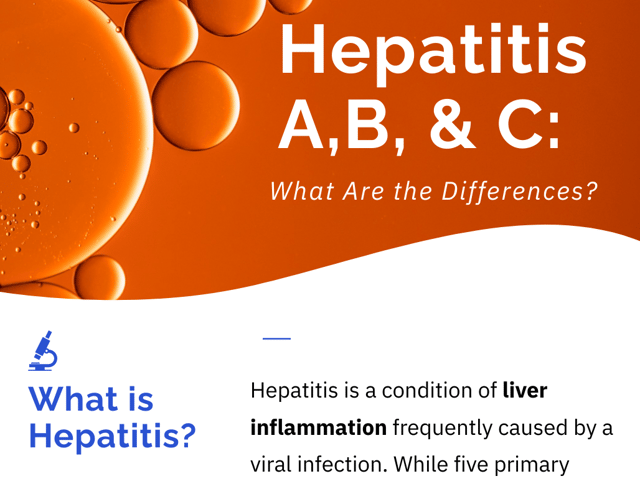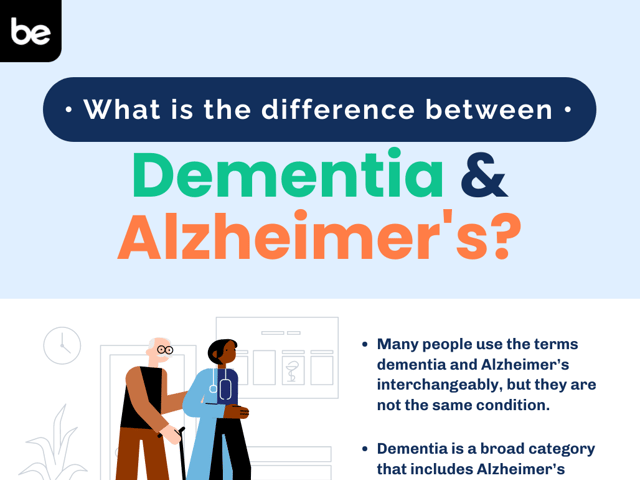
Hepatitis A, B, and C: What Are the Differences?
What Is Hepatitis?
Hepatitis is a condition of liver inflammation frequently caused by a viral infection. While five primary hepatitis viruses exist, Hepatitis A virus (HAV), Hepatitis B virus (HBV), and Hepatitis C virus (HCV) are the most commonly seen in today’s healthcare system.
The Similarities in Hepatitis A, B, and C
All forms of hepatitis present similarly. There are four phases of illness: the incubation phase, the prodromal or pre-icteric (pre-jaundice) phase, the icteric (jaundiced) phase, and the convalescent phase. The incubation phase covers the time between exposure and onset of symptoms and may last a few to several weeks. In the prodromal phase, symptoms of fatigue, muscle aches, nausea, and anorexia present either abruptly or gradually. The icteric phase begins 5 to 10 days after initial symptoms and is classified by the onset of jaundice and color changes of the stool and urine. Finally, the convalescent stage sees slow resolution of jaundice, liver lab levels, and other symptoms.
Knowing that all hepatitis viral infections follow the same pattern of illness, differentiating between the types of hepatitis can be difficult. We will discuss the unique traits of Hepatitis A, Hepatitis B, and Hepatitis C to improve understanding of each illness.
Hepatitis A
Hepatitis A is transmitted via the fecal-oral route, where food and water are consumed after viral contamination from an infected person’s feces. The condition is most commonly seen in young adults, in people living in unsanitary conditions, and in people after international travel. The virus can also be spread during close contact with a person infected with Hepatitis A. Hepatitis A usually has an abrupt onset of symptoms, within 2–6 weeks after viral exposure. Symptoms may last for a few weeks to a few months but are generally self-limiting and often resolve without long-term consequences. The treatment for Hepatitis A involves supportive care and symptom management. A vaccine for Hepatitis A is available in the United States and is recommended for all persons at high risk for Hepatitis A including children, those suffering with chronic disease or other hepatitis illness, people experiencing homelessness, people who use drugs, men who have male sexual partners, international travellers, and those frequently exposed to others with Hepatitis A. Vaccine administration and immunity have greatly decreased the incidence of Hepatitis A outbreaks in the United States.
Hepatitis B
Hepatitis B transmission occurs in the event of exposure to infected blood or bodily fluids. Transmission can also occur in utero between an infected mother and her fetus. Populations at high risk for Hepatitis B include intravenous drug users, healthcare workers, people with multiple sexual partners, people exposed frequently to blood products, fetuses of infected mothers, and people of Asian descent. Hepatitis B can present as acute hepatitis, chronic hepatitis, fulminant hepatitis, or asymptomatic carrier. Hepatitis B becomes a chronic condition in less than 5% of people. In fulminant hepatitis, rapid and progressive development to liver failure ensues 2–3 weeks after initial symptoms. Carriers of hepatitis can infect others through bodily fluid or fetal exposure but do not harbor symptoms of hepatitis in themselves. Approximately \(\frac{2}{3}\) of people do not know they are infected with Hepatitis B. Some long-term complications of Hepatitis B include cirrhosis and liver cancer. Hepatitis B has an incubation period of 6 to 24 weeks. During the prodromal phase, Hepatitis B may cause urticaria, rashes, arthralgias, serum sickness, glomerulonephritis or may be entirely asymptomatic. As with Hepatitis A, treatment for Hepatitis B is supportive in minimizing or relieving symptoms and preventing transmission of disease. In those with chronic Hepatitis B, regular monitoring for liver disease and, occasionally, antiviral medication is indicated. Most people infected with Hepatitis B build antibodies to the virus and cannot be reinfected. There is a vaccine for Hepatitis B that is recommended in infancy/early childhood and in high-risk populations.
Hepatitis C
Hepatitis C transmission occurs with exposure to infected blood and bodily fluids. Populations at high risk for Hepatitis C include intravenous or intranasal drug users who share paraphernalia, patients with blood transfusions or organ transplant prior to 1992, prisoners, people with unregulated tattoos, people with HIV, and infants born to Hepatitis C positive mothers. Approximately 75%–85% of acute Hepatitis C cases develop into chronic hepatitis. It is the most common cause of chronic hepatitis, cirrhosis and liver cancer. Typical incubation period before symptoms is 5–12 weeks. Acute Hepatitis C, though, is usually minimally or completely asymptomatic and can be transmitted for years before the effects of the disease are recognized. Antiviral therapy may be initiated in the event of chronic Hepatitis C and has been shown to cure greater than 90% of cases. There is no vaccine available for Hepatitis C. It is recommended that clients at high risk for Hepatitis C be regularly tested for the virus.
Similarities in Results and Management
Hepatitis A, B, and C all cause varying levels of liver inflammation and long-term damage. Early diagnosis and disease management reduce the incidence of transmission and help to provide the indicated therapies.
Keep Reading

National Council Licensure Examination-Practical Nurse Blog
How Long Should I Study for the NCLEX-PN?
For aspiring nurses, the NCLEX-PN is a critical hurdle on the path to b…

National Council Licensure Examination-Practical Nurse Blog
How to Become an LPN
Would you like to average $30 dollars per hour in a rewarding full-time…

National Council Licensure Examination-Practical Nurse Blog
What Is the Difference between Dementia and Alzheimer’s?
Many people use the terms dementia and Alzheimer’s interchangeably, but…